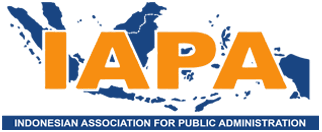Can Decentralization Affect Public Service Delivery? A Preliminay Study of Local Government’s Innovation and Responsiveness in Indonesia.
DOI:
https://doi.org/10.21776/ub.jpas.2017.002.01.7Keywords:
governmnet response, visioner, public service, local government, participation, local’s needAbstract
Decentralization has helped to increase quality of public service to be more responsive and accountable to its local people, but many still question its effectiveness especially in developing coutries. Since 1998, Indonesia has applied decentralization to manage the government, the drastic shift from strong centralization to decentralization has brought question on its effectiveness. This paper presents normative and empirical evidence on decentralization to public service delivery in Indonesia. It analyzes of curent theories and application that support the scheme on how decentralization may reduce ineficiency and ineffeciveness in public service provision. Drawing from articles, the researcher found that efficiency can be increased by providing institutional change to improve accountablity of public service provision. It is recommended that local government should assign specific local bureaucrats to hold reponsible for certain public service that will lead to strong involvement of society and bureaucrats in improving public service provision. The quick bureaucrat response and proper innovation should create strong public service demand on better public service provision and therefore, put high pressure on elite and bureacrats to be more responsive and accountable in managing this service.
References
Adsera A, Boix C, Payne M. 2003. Are you being served? Political accountability and quality of government. The Journal of Law, Economics, and Organization, 19 (2): 445–490. https://doi.org/10.1093/jleo/ewg017
Agrawal A, Ribot J. 1999. Accountability in Decentralization: A Framework with South Asian and West African Cases. The Journal of Developing Areas, 33, (4): 473-502.
Ahmad R. 2006. The role of public administration in building a harmonious society: selected proceedings from the Annual Conference of the Network of Asia-Pacific Schools and Institutes of Public Administration and Governance (NAPSIPAG). Asian Development Bank: Network of Asia-Pacific Schools and Institutes of Public Administration and Governance (NAPSIPAG).
Andrew R, Boyne GA, Law J, Walker RM. 2007. Centralization, Organizational Strategy, and Public Service Performance. Journal of Public Administration Research and Theory, 19 (1): 57–80. https://doi.org/10.1093/jopart/mum039
Antunes P, Karadzic V, Santos R, Beça P, Osann A. 2011. Participatory multi-criteria analysis of irrigation management alternatives: the case of the Caia irrigation district, Portugal. International Journal of Agricultural Sustainability, 9 (2): 334-349.
Antlöv H, Wetterberg A. 2016. Village Governance, Community Life, and the 2014 Village Law in Indonesia. Bulletin of Indonesian Economic Studies, 52 (2): 161-183. http://dx.doi.org/10.1080/00074918.2015.1129047
Auriol, E., Straub, S. & Flochel T. 2016. Public Procurement and Rent-Seeking: The Case of Paraguay. World Development, 77 : 395-407. https://doi.org/10.1016/j.worlddev.2015.09.001
Besley T, & Burgess R. 2002. The political economy of government responsiveness: Theory and evidence from India. The Quarterly Journal of Economics, 117 (4): 1415–1451. https://doi.org/10.1162/003355302320935061
Bertot JC, Jaeger PT, Grimes JM. 2010. Using ICTs to create a culture of transparency: E-government and social media as openness and anti-corruption tools for societies. Government information quarterly, 27 (3): 264-271. https://doi.org/10.1016/j.giq.2010.03.001.
Boin A, Hart P. 2003. Public leadership in times of crisis: mission impossible? Public Administration Review, 63 (5): 544–553DOI: 10.1111/1540-6210.00318
Borins S. 2001. Encouraging innovation in the public sector. Journal of intellectual capital, 2 (3): 310-319. https://doi.org/10.1108/14691930110400128
Boyne GA. 2003. Sources of public service improvement: A critical review and research agenda. Journal of public administration research and theory, 13 (3): 367–394. https://doi.org/10.1093/jpart/mug027
Brinkerhoff DW, Wetterberg A. 2013. Performance-based public management reforms: experience and emerging lessons from service delivery improvement in Indonesia. International Review of Administrative Sciences, 79 (3): 433-457. DOI: https://doi.org/10.1177/0020852313491059
Carina J.2017. Simpang Susun Semanggi yang Dimulai Ahok, Diselesaikan Djarot, dan Akan Diresmikan Jokowi... Kompas, 31 Juli. http://megapolitan.kompas.com/read/2017/07/31/08040941/simpang-susun-semanggi-yang-dimulai-ahok-diselesaikan-djarot-dan-akan?page=all
Crewson PE. 1997. Public-service motivation: Building empirical evidence of incidence and effect. Journal Of Public Administration Research And Theory, 7 (4): 499–518, https://doi.org/10.1093/oxfordjournals.jpart.a024363
Dasgupta A, Beard VA. 2007. Community driven development, collective action and elite capture in Indonesia. Development and change, 38 (2): 229–249. DOI: 10.1111/j.1467-7660.2007.00410.x
Davis J. 2004 Corruption in public service delivery: experience from South Asia’s water and sanitation sector. World development, 32 (1): 53-71. https://doi.org/10.1016/j.worlddev.2003.07.003
Durand, C. & Fournier S. 2017. Can Geographical Indications Modernize Indonesian and Vietnamese Agriculture? Analyzing the Role of National and Local Governments and Producers’ Strategies. World Development, Volume 98, , Pages 93-104. https://doi.org/10.1016/j.worlddev.2015.11.022
Falloon and Betts, 2010. Climate impacts on European agriculture and water management in the context of adaptation and mitigation—the importance of an integrated approach. Science of the total environment, 408 (23):5667-5687. https://doi.org/10.1016/j.scitotenv.2009.05.002
Fanani A. 2017a. Tiga Inovasi Pelayanan Publik Banyuwangi Ikuti Kompetisi Dunia. Detik, 24 Februari. https://news.detik.com/berita-jawa-timur/d-3431283/tiga-inovasi-pelayanan-publik-banyuwangi-ikuti-kompetisi-dunia
Fanani A. 2017b. Program Jemput Bola Pasien Banyuwangi Tangani 1.641 Warga. Detik, 24 Februari. https://news.detik.com/berita-jawa-timur/d-3556721/program-jemput-bola-pasien-banyuwangi-tangani-1641-warga
Gibson CC, McKean MA, Ostrom E.2000. People and forests: Communities, institutions, and governance. MIT Press.
Grimsey, Lewis. 2002. Evaluating the risks of public private partnerships for infrastructure projects. International Journal of Project Management, 20 (2): 107-118. https://doi.org/10.1016/S0263-7863(00)00040-5
Guess GM. 2005. Comparative Decentralization Lessons from Pakistan, Indonesia, and the Philippines. Public Administration Review, 65 (2): 217–230. DOI: 10.1111/j.1540-6210.2005.00446.x
Kahkonen S, Lanyi, A. 2001. Decentralization and Governance : Does Decentralization Improve Public Service Delivery? World bank notes, No 55. Retrieved at https//.worldbank.org
Khaleghian P. 2004, Decentralization and public services: the case of immunization. Social Science & Medicine, 59, Issue 1, Pages 163-183. https://doi.org/10.1016/j.socscimed.2003.10.013
Kingsley GT. 1996. Perspectives on Devolution. Journal of the American Planning Association, 62 (4): 419-426. http://dx.doi.org/10.1080/01944369608975709
Kis-Katos K, Sjahrir BS. 2017. The impact of fiscal and political decentralization on local public investment in Indonesia. Journal of Comparative Economics, 45 (2): 344-365. https://doi.org/10.1016/j.jce.2017.03.003
Lewis BD, McCulloch N, Sacks A. 2016. Measuring local government service delivery performance: Challenges and (partial) solutions in Indonesia. Journal of International development, 28 (5): 808–817. DOI: 10.1002/jid.3106
Manor J. 1999. The political economy of democratic decentralization. Washingthon DC: The World Bank. www-wds.worldbank.org
Ostorm E. 1990. Governing the commons : The evolution of institutions for collective action. Cambridge, Cambridge University
Perry JL, Wise LR. 1990. The motivational bases of public service. Public Administration Review, 50 (3): 367-373. DOI: 10.2307/976618.
Przeworski A, Stokes SC, Manin B. 1999. Democracy, accountability, and representation. New York: Cambridge University Press
Ramesh M. 2013. Decentralization in Asia: survey. Policy and Society, 32 (1):1-5. http://www.tandfonline.com/doi/full/10.1016/j.polsoc.2013.02.004
Ricart S, Clarimont S. 2016. Modelling the links between irrigation, ecosystem services and rural development in pursuit of social legitimacy: Results from a territorial analysis of the Neste System (Hautes-Pyrénées, France). Journal of Rural Studies, 43: 1-12. https://doi.org/10.1016/j.jrurstud.2015.09.012
Ricks JI. 2016. Building Participatory Organizations for Common Pool Resource Management: Water User Group Promotion in Indonesia. World Development, 77: 34-47. https://doi.org/10.1016/j.worlddev.2015.08.014
Roberts A. 2006. Blacked out: Government secrecy in the information age. Cambridge University Press.
Smoke P. 2015. Rethinking decentralization: Assessing challenges to a popular public sector reform. Public Administration and Development, 35 (2): 97–112. DOI: 10.1002/pad.1703
Sujarwoto, S. (2017). Why decentralization works and does not works? A systematic literature review. Journal of Public Administration Studies, 1(3), 1-10.
Widianingsih I. 2014. Decentralized Governance and Delivery of Services: Lessons Learned from Jembrana District. Retrieved from www.academia.edu
Winters MS, Karim AG, Martawardaya B. 2014. Public service provision under conditions of insufficient citizen demand: Insights from the urban sanitation sector in Indonesia. World development, 60: 31-42. https://doi.org/10.1016/j.worlddev.2014.03.017
Downloads
Published
Issue
Section
License
Copyright Statement
Authors who publish with JPAS agree to the following terms:
(1). Authors retain copyright and grant the journal right of first publication with the work simultaneously licensed under a Creative Commons Attribution License that allows others to share the work with an acknowledgement of the work's authorship and initial publication in this journal.
(2). Authors are able to enter into separate, additional contractual arrangements for the non-exclusive distribution of the journal's published version of the work (e.g., post it to an institutional repository or publish it in a book), with an acknowledgement of its initial publication in this journal.
(3). Authors are permitted and encouraged to post their work online (e.g., in institutional repositories or on their website) prior to and during the submission process, as it can lead to productive exchanges, as well as earlier and greater citation of published work (See The Effect of Open Access).
Permissions and reuse
For authors
Authors may use their own articles for the following non-commercial purposes without asking our permission (and subject only to acknowledging first publication in JPAS and giving a full reference or web link, as appropriate).
(1). Posting a pdf of their own article on their own personal or institutional website, for which no charge for access is made.
(2). Making a reasonable number of copies for personal or non commercial professional use.
This includes the contributors own teaching purposes.
(1). Republishing part or all of the article in a book or other publication edited by the author (except for multiple contributions in the same book or publication, for which permission needs to be sought.
(2). Using individual figures or tables or extracts of text (up to 300 words) in other publications published by a third party.
(3). Using the article in a course pack or compilation (whether paper or electronic) in the authors institution. This does not apply if a commercial charge is made for the compilation or training programme.
For third parties
All articles published by JPAS are published by default as open access.















